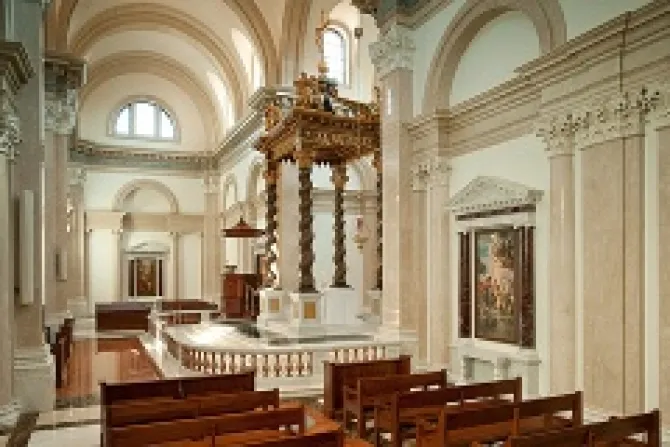South Bend, Ind., Mar 19, 2013 / 03:02 am
Because they help impart the Catholic faith to the world, Church buildings have a responsibility to reflect God's beauty, says architect and author Duncan Stroik.
"You learn your faith through the (church) building; they're sermons in stone, and that's why they're so important," Stroik, a professor at the University of Notre Dame's School of Architecture, told CNA March 14.
"There's no question in my mind that the architecture we built in the last 40 years did not help us in retaining the faith of the young, and didn't do a great job in evangelizing," added Stroik, who penned the recent book, "The Church Building as a Sacred Place."
"Generations of people have grown up in these banal buildings, which have taught them either nothing, or the wrong things about the faith, and that's why architecture is so important."
Stroik's new work, subtitled "Beauty, Transcendence, and the Eternal," is meant to guide pastors, parishioners, patrons and architects as they set out to renovate existing churches or build new structures entirely. It was published in December 2012 by Liturgy Training Publications.
The book is composed of numerous essays outlining principles of church buildings, examining the history of both classical and modernist architecture, and looking to the future of sacred architecture.
"I'd like to put the book in context, in the sense that I see a huge renaissance of sacred architecture in this country that's taken place over the last 20 years...this book is coming at a time when we've had a great sea change in the way Catholics think about their churches," he said.
"Most parishes want something that looks like a church...there's a desire for beauty. Now how do we do it? And I like to think this book can be part of that," he said, to help those who want to build beautiful, traditional churches.
Stroik said that while there have been "great successes" in Catholic architecture in the past 20 years, still more remains to be done.
"We need to do a better job. We haven't built a new church in the last 50 years that is as good as the best things we built in 1920, or 1820." We need to "hit that high standard" he said, of "the best things."
"I'd like to raise the standards...we really need to raise our eyesight, to look on the great things of the past."
Stroik noted that not all church buildings that are old are necessarily good, and that we should look to the best among them, pointing out the cathedrals of Chartres and Florence, and in the U.S., St. Patrick's in New York City and the cathedrals of Baltimore and Philadelphia.
"Our goal should be to be as good, or better, than Baltimore, or Chartres."
Stroik, who designed the Thomas Aquinas College Chapel in Santa Paula and the Shrine of Our Lady of Guadalupe in La Crosse, pointed out that contrary to the thought of modernist architects, working within the tradition leaves "a lot of room...for a variety of styles, of ways of designing a church" and that creativity is welcomed in classical architecture.
He compared working within the tradition of architecture to working within the tradition of theology.
"You have a whole lot of stuff that's out there that you can learn from, and that you want to learn from, but there is development in theology, and in architecture, and it's very creative."
In his book, Stroik writes that he intends to move Catholics away from "merely the construction of 'worship spaces'" and towards the creation of sacred architecture.
"Walking into a church, our vision is meant to be of the heavenly city...there's a different kind of vision, it's a view to the world as it should be, to the heavenly realm," he told CNA.
He mentioned that while he believes sacred architecture should have height, directionality, iconography, and a clear sanctuary, within those confines, "there's room for many solutions, for different architecture, and for people to do different things."
Churches built in the past 40 years have not generally conveyed a vision of the heavenly city, Stroik reflected. This is largely because of the modernist elements of functionality and iconoclasm -- the rejection of sacred images and statues.
"Often we're not conscience of what we've learned from these buildings, but we've learned a lot."
Architecture "teaches us the wrong things, or the right things; that's why it's so important. Our kids are growing up and worshiping in these churches, and that's what they're learning about the faith."
To have a "healthy Church," Stroik said, "we have to use all the tools we have...and architecture is one of them. It's not the most important or the only one, but it is an important one."
Stroik hopes "The Church Building as a Sacred Place" will impact patrons of sacred architecture, without whom the creation of churches to rival the Baltimore and Philadelphia cathedrals will not be possible.
"You need a great patron, one who is informed and educated about art and architecture, and who cares about and wants the best, and a really great architect, who is supported, and challenged, by the patron.
"I like to think this book can help the architect and the the patron to prepare for their project," he said, and to "help us all" rise the tide of Catholic architecture, lifting all boats.
"In my philosophy about church architecture, I try to be as broad, as inclusive as possible," Stroik explained.
Looking at the 2000 year history of Catholic architecture, Stroik uses examples from diverse times and places, "so this is a book not just for Americans, or the 21st century."
"I'm really interested in those things which transcend our period, and even our regions...there are things relevant across the world to Catholics, and if I've done any little bit of that, there's something for everyone in the book."



